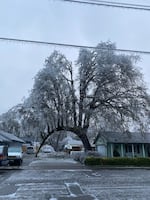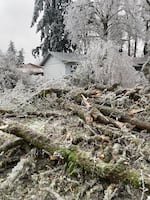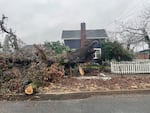When the overdue Cascadia megaquake hits Oregon, towns across the state could find themselves largely cut off from the outside world, without power, roads blocked, cellular towers down, and no supplies getting in or out for weeks at a time.
Cottage Grove, a city of a little over 10,000 people just south of Eugene, got a taste of what that’s like this week.
Freezing rain on Saturday encased the town in ice an inch or more thick. Roads were blocked by falling trees or too slick to drive. Cell service was disrupted, residents told OPB. Power went out across the town for six days. Just City Hall and the hospital stayed open, running on generators.

The "archway tree," one of thousands damaged by this week's ice storm in Cottage Grove, Ore.
Courtesy of Arin Flory
When the ice storm started, Kathryn Porter, 76, was at home with her two cats, Latte and Cup of Joe.
Porter lives in a hillside development on the west side of town. It was built in the 1970s, on an old Weyerhaeuser tree farm.
“It’s all Doug fir up here,” she said. “The branches were parallel to the trunks, they were so weighted down.”
For four days after she lost power, Porter kept her woodstove going and listened to the storm.
“You could hear the branches breaking and the trees falling because of the weight of the ice,” she said.
One tree came down on her roof. But Porter counts herself lucky, because other neighbors took bigger hits.
“We’ve tarped it and I have a wonderful guy who’s a really good woodsman, and he’s removed the tree from the house,” she said.
Porter’s woodstove isn’t supposed to run continuously, so she only lit it twice a day, bringing the temperature inside the house to just 45 degrees.
Her experience was not unique, and after nearly a week of icy hell, people who live in Cottage Grove are just now starting to recover.
Related: On KLCC.org: Amid Lane County power outages, some customers are required to do their own repairs
The city’s response
Faye Stewart, Cottage Grove’s interim city manager, said his Saturday started off unremarkably. He had a morning coffee at the masonic lodge, and then headed to the office to do paperwork. It was raining when he went inside.

A house in Cottage Grove this week. Houses across Lane County have been damaged by falling trees and debris.
Courtesy of Arin Flory
“When I opened the door at 1:30, there were icicles on the trees and fences,” he said.
Stewart and his crews spent the next five days keeping a few core services — water and wastewater treatment — running, using generators to power pumps, as the fuel supply in the town dwindled.
Just a few miles south of the town, rain had fallen instead of freezing rain, and stores were open. But getting outside the community to supplies — or a hotel — was near impossible. The roads out of town became ice rinks.
“All the roads to and from I-5 were closed,” Stewart said. “It took one individual, from Curtain, about two miles away, 13 hours to get here.”
City Hall, which had power thanks to a generator, became a de facto warming shelter for Cottage Grove residents, staffed by the mayor and volunteers.
“We started out the first night with three people. Last night, there were 43 people,” Stewart said, in an interview Thursday.
“There’s people sitting all along the dias. They’re just stuffed in there. They have dog food on the floor,” said Greg Ervin, a member of the City Council.
Internet was out, and AT&T and Verizon cellphones lost service, according to Ervin. “That was the most unnerving thing,” he said. To communicate with outsiders, he had to text from a neighbor’s phone that had T-mobile.
Neighbors help each other
As the power outage dragged on, people with generators sheltered their neighbors. Ervin, who had gas heat and an electric generator, took in the 87-year-old woman who lives next door. Then one of his son’s friends. Next came relatives and people who’d been stranded. His son gave up his bed and slept by the fire. Soon, there were 14 people in the house. They cooked for everyone using a Dutch oven in a backyard fire pit.
“A friend had some backstrap from a deer, from a year ago in the freezer. We cooked that up,” Ervin said, noting they also ate spaghetti and chicken and dumplings.
Helping neighbors has given people something to do, and kept morale up as Cottage Grove waited for the ice to thaw and help to arrive.
“It was a big maze of how do we get everybody comfortable, warm,” Ervin said.

A tree fallen in front of a house in Cottage Grove following this week's storm.
Faye Stewart
After four days, Porter decided her house was too cold. She packed up the cats and moved in with a friend who had a generator.
About 50 trees had fallen on her street, she estimated. But she was able to get to warmth and safety because each time a tree fell, her neighbors with chainsaws would come and clear the road.
“It is a joy to see a community working together,” Porter said.
Not everyone fared as well. Statewide, at least 12 people have lost their lives due to hypothermia and storm related accidents. Police have also indicated that some traffic fatalities the past week across the state happened because of icy roads. In Cottage Grove, one person died in a house fire, which city officials suspect was started by a propane heater used to keep warm.
A second wave of destruction
By Tuesday, town residents hoped for a reprieve. Pacific Power, which provides electricity for Main Street and the central part of town, had arrived and made progress repairing poles, lines and a substation.
As temperatures later in the week started to quickly climb above freezing, the situation got worse, however. When the weight of the ice finally lifted, tree branches and power lines snapped back in the other direction, causing even more damage due to the recoil.
“More stuff started cracking and snapping,” Ervin said. “The crews that were restoring lines were playing whack-a-mole.”
“It was heartbreaking,” Stewart added. “All the work we did to get things repaired, and it was all back on the ground.”
By Thursday, the situation in Cottage Grove and the surrounding areas was finally improving. Linemen from across the state have been replacing poles, rebuilding transmission lines, and restoring power to hard hit communities across Lane County.
But power companies are warning that given the extent of the damage, some people could see outages drag on for another week.
Ervin said in his neighborhood, falling branches ripped off or bent the weatherheads that connect power lines to individual houses, which will leave some houses cut off from the grid for longer.
Long recovery
Kathryn Porter has returned home, but the power is still out in her neighborhood, which is served by Emerald People’s Utility District, one of the harder hit utilities in the state. She’s heard it may take until next Friday to restore electricity.
There’s a tarp on the roof and the house is cold, but Latte and Cup of Joe are happy to be back.
“They’ve gotten themselves under the covers. I’ll sleep tonight,” Porter said.
The mayor and City Council will start tallying up the damage soon, and figure out what can get reimbursed by the state and federal government. On Friday, Gov. Tina Kotek declared a statewide emergency due to the storm.

Volunteer Arin Flory has been using his winch and chainsaw to help clear streets and driveways in Cottage Grove after the ice storm.
Courtesy of Arin Flory
With the most immediate phase of the crisis lifting, Stewart, the interim city manager, is reflecting on what it took to survive the past week.
Oregon, he said, needs to be better prepared for extreme weather. Climate change is the new reality. Just in recent years, Stewart endured the so-called “snowmageddon” in 2019, the 2020 wildfire in the Makenzie River basin, part of the most destructive wildfire season on record in Oregon, and now this.
“We’ve just seen natural disasters that have been a higher level of impact than they’ve ever been, at least in my lifetime,” he said.
And, he added, it’s going to take a lot more to prepare the state for a Cascadia quake, which could interrupt fuel and basic services for 30 days or more.
“We struggled to make it five or six here,” he said. “Can you imagine what it would be like?”
